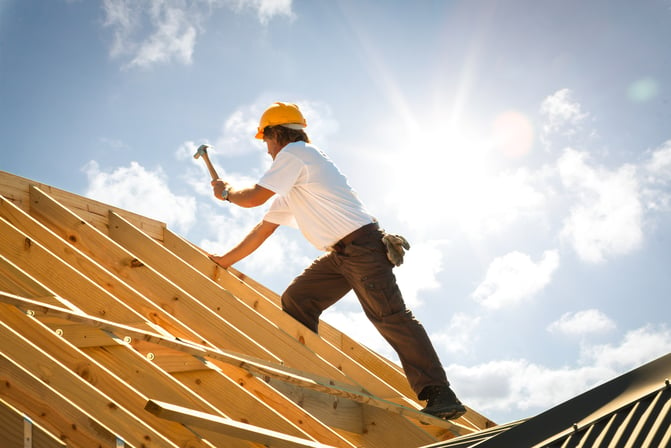Building a House in Florida: Everything You Need To Know

If it’s your dream to build a house in Florida, you might be able to make it a reality so long as it's within the budget. So how much does it cost to build a new house in Florida?
Here’s everything you need to know to calculate the costs and navigate the process:
Why Should You Build Instead of Buy in Florida?
Purchasing a house in the Sunshine State is a no-brainer, but should you buy an existing home or build one from scratch?
Here are some reasons why you may want to consider building a new home instead of buying an existing one:
- Lower costs: Building instead of buying could actually save you money. The average cost of a new-build house is $284,000, whereas the average cost of an existing home is slightly more at $293,349.
- More customization: Building instead of buying allows you to pick and choose the features of your house based on your wants and needs. With a new build, you won’t be forced to compromise on certain things or be stuck with the design choices of the previous owner that might not be your style.
- Less maintenance: Building instead of buying comes with less maintenance since everything is brand new. And if something does need to be repaired or replaced, many builders offer warranties for new homes that will cover these costs.
- More energy-efficient: Building instead of buying often results in a more energy-efficient home that’s better for the environment and lowers your electric bills.
How Much Does It Cost To Build a House in Florida?
As you can see, one of the main reasons why you should build instead of buy relates to cost. In the past, building a house was almost always more expensive than buying one. However, things have changed, and it’s possible for you to actually save money by building instead of buying.
But just how much does it cost to build a house in Florida, and how much money can you save? The cost of building a house in Florida really depends on your location, builder, and chosen features. For example, a basic three-bedroom, two-bathroom house in Jacksonville is going to cost a lot less than a custom-built five-bedroom, three-bathroom house in Miami.
To give you an idea, the average cost to build a new home in Florida currently ranges between $240,000 and $350,000. If you’re looking for a more concrete number within this large range, you can calculate the cost per square foot.
On average, the cost to build a new home in the South is about $110.19 per square foot. So if you have a 2,000 square foot house, you can expect to pay around $220,380.
What Is the Process of Building a House in Florida?
Now that you know more about the cost of building a house in Florida, let’s talk about the building process:
Step 1: Narrowing Down Location
Step one to building a house involves narrowing down your location. What area do you want to be in? Are you looking for a neighborhood with a lot of amenities? Are you looking for a small, medium, or large community? What are the schools like in the community? These are all things to consider when choosing a location.
Step 2: Finding a Builder
Once you have identified a specific area, you can work on finding a builder that’s currently building there. Many builders have websites that you can browse online with information about their communities. However, it may also be helpful to simply get in the car and drive around your target area to see the different neighborhoods and builders.
When choosing a home builder, you’re obviously looking for the best. After all, your home is likely your largest investment. Look for builders that have been in business for a long time and are well-known for their quality and customer service. Check out customer reviews and complaints on platforms like the Better Business Bureau (BBB) for helpful insight into these factors.
Step 3: Choosing a Lot and Plan
Now that you have chosen a neighborhood and a builder, you’ll be able to choose a lot and a home plan based on what’s available. Most builders have a wide variety of different lot sizes and home plans to meet your needs.
For example, you might be able to choose between a large corner lot or a smaller middle lot. You might also be able to choose a lot with a lake view or a wooded view. Just expect to pay higher prices for premium lots that are bigger or that have better views.
Additionally, you might also be able to choose between a Mediterranean-style house or a Craftsman-style house. You can choose the number of bedrooms, bathrooms, stories, and square feet that your house has.
And while this is the most common approach to building a house, you may also be able to completely customize your house from top to bottom when you work with a builder and an architect.
On the other end of the spectrum, there are tract homes that come pre-built with the lot, plan, and design features already selected by the builder. Choosing a tract home is a great option if you’re on a limited timeframe and need to get into a house quickly.
Step 4: Making Customizations
Choosing your lot and home plan is hard enough, but you’ll have to make many more choices when it comes to customizing your new build. Most builders will allow you to select your finishes, including your flooring, paint, cabinets, and countertops.
You will also be able to upgrade different features of your home, for example, adding an extra sink to the guest bathroom, tray ceilings in the master bedroom, and a walk-in pantry in the kitchen. Again, all of these upgrades will add to the final cost of your new build.
Step 5: Building the Home
Once you’ve made all your selections, it’s finally time to start building your new house. The building process itself can take several months, depending on supply availability.
Here’s a quick look into what this actually entails:
- Permits are obtained. The site is leveled and prepared for the foundation.
- Footings are installed, the foundation is poured, and drains are installed.
- Frame is built, and sheathing is applied to exterior walls.
- Windows and doors are installed.
- Plumbing, electric, and HVAC systems are installed.
- Roof and insulation are installed.
- Drywall is hung, walls and ceilings are textured, and walls are painted.
- Flooring is laid; trim is completed.
- Cabinets, light fixtures, outlets, and switches are installed.
- Countertops, appliances, and additional fixtures are installed.
- Landscaping is completed.
Step 6: Inspecting the Home
Even with a brand new house, a home inspection is still incredibly important. An inspector will make sure that all systems are properly functioning and that there aren’t any overall issues with the construction. If the house passes the inspection, it will receive a certificate of occupancy to indicate that it’s safe to live in.
Step 7: Closing on the Home
After the inspection process is completed, you will attend a final walkthrough right before you close. During the final walkthrough, you’ll want to check for any signs of damage or faulty construction/installation. If everything looks good in the final walkthrough, you’ll be all set to close on your new home.
Where To Build a New House in Florida
Florida is a large state with a lot to offer. There are bustling cities, stunning beaches, and peaceful countryside. At the end of the day, there’s no “wrong” place to build in Florida — it really comes down to your preferences.
If you’re looking for quick access to the best beaches and entertainment that Florida has to offer, then you should definitely consider building in South Florida locations like Miami, Fort Lauderdale, and West Palm Beach.
On the other hand, if you’re looking for a mid-sized city that still has plenty to do, then you should check out the Tampa Bay, Jacksonville, and Orlando areas. Finally, if you’re looking for something more rural and calm, Tallahassee, Gainesville, and Pensacola are good options.
How To Finance a New Build in Florida
Unless you’re able to pay for your new build in cash, you’re going to need financing. This can be tricky, especially if you’re custom-building your home from scratch. If that’s the case, you’re likely to need a construction loan rather than a conventional loan.
Another great option is a bridge loan that’s designed to help you bridge the gap between the construction process and actually closing on the home.
Final Thoughts
No matter which type of loan you’re looking for, Vaster is here to help with an experienced team of lending and real estate experts.
Vaster specializes in South Florida and is very familiar with the market for new build condos and single-family homes. For more insight and information into building a new home in Florida, reach out to the team today.
Sources:
The Pros and Cons of Buying New Construction | Moving.com
Be the first to know.
Get exclusive access to our latest insights and upcoming events

Sign up
Get first access to all of our industry articles, reports, and downloadable content.
